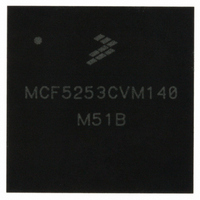MCF5253CVM140 Freescale Semiconductor, MCF5253CVM140 Datasheet - Page 641

MCF5253CVM140
Manufacturer Part Number
MCF5253CVM140
Description
IC MPU 32BIT 140MHZ 225-MAPBGA
Manufacturer
Freescale Semiconductor
Series
MCF525xr
Datasheets
1.MCF5253VM140J.pdf
(34 pages)
2.MCF5253VM140J.pdf
(8 pages)
3.MCF5253VM140J.pdf
(648 pages)
4.MCF5253VM140J.pdf
(2 pages)
Specifications of MCF5253CVM140
Core Processor
Coldfire V2
Core Size
32-Bit
Speed
140MHz
Connectivity
CAN, EBI/EMI, I²C, QSPI, UART/USART, USB OTG
Peripherals
DMA, WDT
Program Memory Type
ROMless
Ram Size
128K x 8
Voltage - Supply (vcc/vdd)
1.08 V ~ 1.32 V
Data Converters
A/D 6x12b
Oscillator Type
External
Operating Temperature
-40°C ~ 85°C
Package / Case
225-MAPBGA
Family Name
MCF5xxx
Device Core
ColdFire V2
Device Core Size
32b
Frequency (max)
140MHz
Instruction Set Architecture
RISC
Supply Voltage 1 (typ)
1.2/3.3V
Operating Supply Voltage (max)
1.32/3.6V
Operating Supply Voltage (min)
1.08/3V
Operating Temp Range
-40C to 85C
Operating Temperature Classification
Industrial
Mounting
Surface Mount
Pin Count
225
Package Type
MA-BGA
Lead Free Status / RoHS Status
Lead free / RoHS Compliant
Number Of I /o
-
Eeprom Size
-
Program Memory Size
-
Lead Free Status / Rohs Status
Compliant
Available stocks
Company
Part Number
Manufacturer
Quantity
Price
Company:
Part Number:
MCF5253CVM140
Manufacturer:
FREESCALE
Quantity:
300
Company:
Part Number:
MCF5253CVM140
Manufacturer:
Freescale Semiconductor
Quantity:
10 000
Part Number:
MCF5253CVM140
Manufacturer:
FREESCALE
Quantity:
20 000
Company:
Part Number:
MCF5253CVM140J
Manufacturer:
Freescale Semiconductor
Quantity:
10 000
- MCF5253VM140J PDF datasheet
- MCF5253VM140J PDF datasheet #2
- MCF5253VM140J PDF datasheet #3
- MCF5253VM140J PDF datasheet #4
- Current page: 641 of 648
- Download datasheet (8Mb)
The purpose of deactivation is data coherency. The match/arbitration process scans the MBs to decide
which MB to transmit or receive. If the CPU updates the MB in the middle of a match or arbitration
process, the data of that MB may no longer be coherent; therefore, that MB is deactivated.
Even with the coherence mechanism described above, writing to the C/S word of active MBs when not in
freeze mode may produce undesirable results. Examples are:
25.6.5.3
Besides message buffer deactivation, the lock/release/busy mechanism is designed to guarantee data
coherency during the receive process. The following examples demonstrate how the lock/release/busy
mechanism will affect FlexCAN operation:
Freescale Semiconductor
•
•
•
1. Reading a control/status word of a message buffer triggers a lock for that message buffer. A new
2. To release a locked message buffer, the CPU either locks another message buffer (by reading its
3. If a receive frame with a matching ID is received during the time the message buffer is locked, the
4. When a locked message buffer is released, if a frame with a matching identifier exists within the
5. If two or more receive frames with matching IDs are received while a message buffer with a
Matching and arbitration are one-pass processes. If MBs are deactivated after they are scanned, no
re-evaluation is done to determine a new match/winner. If an Rx MB with a matching ID is
deactivated during the matching process after it was scanned, then this MB is marked as invalid to
receive the frame, and FlexCAN will keep looking for another matching MB within the ones it has
not scanned yet. If it can not find one, then the message will be lost. Suppose, for example, that two
MBs have a matching ID to a received frame, and the user deactivated the first matching MB after
FlexCAN has scanned the second. The received frame will be lost even if the second matching MB
was free to receive.
If a Tx MB containing the lowest ID is deactivated after the FlexCAN has scanned it, then the
FlexCAN will look for another winner within the MBs that it has not yet scanned. Therefore, it may
transmit an MB that may not have the lowest ID at the time because a lower ID might be present
that it had already scanned before the deactivation.
There is a point in time until which the deactivation of a Tx MB causes it not to be transmitted (end
of move-out). After this point, it is transmitted, but no interrupt is issued and the CODE field is not
updated.
received message frame that matches the message buffer cannot be written into this message buffer
while it is locked.
control/status word) or globally releases any locked message buffer (by reading the free-running
timer).
receive frame will not be immediately transferred into that message buffer, but will remain in the
SMB. There is no indication when this occurs.
SMB, then this frame will be transferred to the matching message buffer.
matching ID is locked, the last received frame with that ID is kept within the serial message buffer,
while all preceding ones are lost. There is no indication of lost messages when this occurs.
Locking and Releasing Message Buffers
MCF5253 Reference Manual, Rev. 1
FlexCAN Module
25-25
Related parts for MCF5253CVM140
Image
Part Number
Description
Manufacturer
Datasheet
Request
R
Part Number:
Description:
Mcf5253 Coldfire? Microprocessor Data Sheet
Manufacturer:
Freescale Semiconductor, Inc
Datasheet:
Part Number:
Description:
Manufacturer:
Freescale Semiconductor, Inc
Datasheet:
Part Number:
Description:
Manufacturer:
Freescale Semiconductor, Inc
Datasheet:
Part Number:
Description:
Manufacturer:
Freescale Semiconductor, Inc
Datasheet:
Part Number:
Description:
Manufacturer:
Freescale Semiconductor, Inc
Datasheet:
Part Number:
Description:
Manufacturer:
Freescale Semiconductor, Inc
Datasheet:
Part Number:
Description:
Manufacturer:
Freescale Semiconductor, Inc
Datasheet:
Part Number:
Description:
Manufacturer:
Freescale Semiconductor, Inc
Datasheet:
Part Number:
Description:
Manufacturer:
Freescale Semiconductor, Inc
Datasheet:
Part Number:
Description:
Manufacturer:
Freescale Semiconductor, Inc
Datasheet:
Part Number:
Description:
Manufacturer:
Freescale Semiconductor, Inc
Datasheet:
Part Number:
Description:
Manufacturer:
Freescale Semiconductor, Inc
Datasheet:
Part Number:
Description:
Manufacturer:
Freescale Semiconductor, Inc
Datasheet:
Part Number:
Description:
Manufacturer:
Freescale Semiconductor, Inc
Datasheet:
Part Number:
Description:
Manufacturer:
Freescale Semiconductor, Inc
Datasheet:









